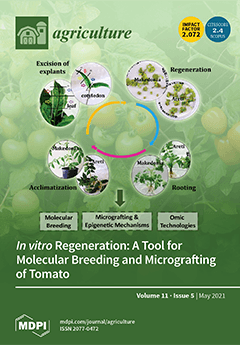It is well known that submerged soils emit high levels of methane (CH
4) due to oxygen deprivation and free iron oxide causing a quick reduction. However, there are other soil properties that control the reduction processes in soil, especially the amount of soil organic carbon (SOC). This study aimed to investigate the major factors controlling CH
4 production potential (CH
4PP) in Thai paddy fields. Two provinces, Ayutthaya, a clay soil region, and Khonkaen, a sandy soil region, were selected to represent a wide range of soil textures. Soil characteristic analysis pre- and post-incubation, and weekly gas detection in an incubation experiment over two months, was conducted. Stepwise multiple regression analysis was employed to analyze major soil factors controlling CH
4PP. For the regional prediction of CH
4PP, a map dataset of Ayutthaya and Khonkaen by the Land Development Department, Thailand, and a soil texture map (with intersected point data using the soil property map in ArcGIS) by OpenLandMap, were used. CH
4PP was correlated with 1:10 pH, Fe
2+, and water-soluble organic carbon (WSOC) measured after incubation. Although CH
4PP showed no significant correlation with any soil properties measured before incubation, CH
4PP was correlated with SOC, 1:10 electrical conductivity (EC), exchangeable ammonium (ExNH
4), and sand content. It was thought that SOC and ExNH
4 were related to organic matter decomposition, 1:10 EC was related to SO
42− reduction and sand content was related to free oxides. Predicted regional CH
4PP was similar in Ayutthaya and Khonkaen, although SOC, ExNH
4 and 1:10 EC was higher, and sand content was lower in Ayutthaya than in Khonkaen. In both regions, the distribution of CH
4PP corresponded to SOC, and CH
4PP was lower with lower sand content and higher 1:10 EC. In clayey Ayutthaya, higher CH
4PP was observed in the area with higher ExNH
4. This indicates that soil properties other than soil texture and SOC influence CH
4PP in the paddy fields in Thailand.
Full article





